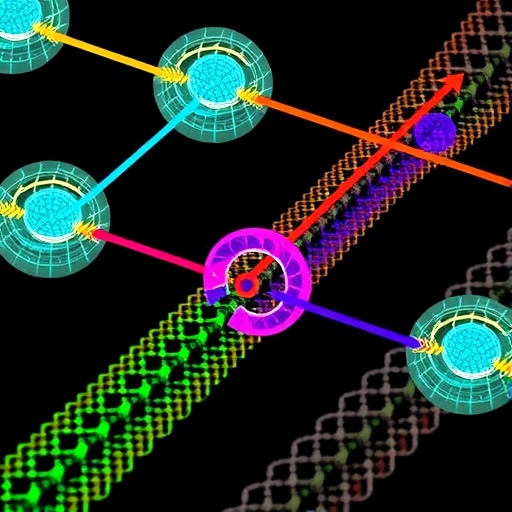In the rapidly evolving field of optics, the ability to control the nonlinear phase of light dynamically has emerged as a significant frontier, unlocking enhanced flexibility, adaptability, and functionality across a spectrum of applications. This advancement promises to transform areas such as telecommunications, quantum computing, imaging, and adaptive optics. However, two substantial hurdles persist in realizing this potential: the complexity and energy demands of current fabrication processes, as well as the limitations inherent in static optical systems whose properties are fixed post-manufacture.
Recently, a group of scientists led by Assistant Professor Ling-Ling Ma and Professor Yan-Qing Lu from the National Laboratory of Solid State Microstructures and the Key Laboratory of Intelligent Optical Sensing and Manipulation at Nanjing University, China, has addressed these challenges by presenting a breakthrough approach utilizing nonlinear Pancharatnam-Berry ferroelectric nematics. This innovative strategy introduces a new paradigm for manipulating the nonlinear phase of light through the intricate design of liquid crystal materials.
The research highlights the profound implications of the orientation angle of the medium’s anisotropic structure and the spin state of incident light on the Pancharatnam-Berry phase shifts. This nuanced understanding allows for a more intuitive representation of the linear and nonlinear Pancharatnam-Berry phase shifts in liquid crystals, paving the way for the development of advanced optical systems that leverage these properties for enhanced performance.
One of the standout features of the experimental findings is the introduction and successful application of ion-doped ferroelectric nematic liquid crystal (FNLC) devices, which are characterized by expansive, defect-free polarization patterns. The scalability of these devices is crucial, as it underscores their potential for integration into more extensive optical systems, thereby ensuring that the promise of reconfigurable optics can be extended beyond the laboratory and into practical, real-world environments.
The research emphasizes the capacity for dynamic control over the in-plane orientation of polar liquid crystals with remarkably low electric fields, specifically around 0.06 V/μm. This low-energy requirement not only facilitates real-time and continuous adjustments of the nonlinear Pancharatnam-Berry phase imparted to the generated nonlinear beam but also ensures that the modifications can be seamlessly integrated into existing optical configurations.
The team’s findings demonstrate both theoretical and experimental advancements in the precise and reconfigurable steering of second harmonic signals. Through intricate patterns of geometric rotations, the researchers reveal the ability to control key parameters such as diffraction orders, intensity patterns, and polarization states. This level of dynamic control not only showcases the potential for high-precision manipulation of light but also sets the stage for future innovations in nonlinear photonic devices.
Moreover, this research heralds a significant step forward in the realm of nonlinear optics by showcasing how ion-doped FNLCs can serve as effective platforms for reconfigurable nonlinear Pancharatnam-Berry liquid crystal optics. The implications of these advancements span a myriad of applications, including advanced optical processing, adaptive optics, and the rapidly expanding field of quantum information technologies.
Unique to this study is the prospect of dynamically tuning the nonlinear Pancharatnam-Berry phase within FNLCs, which offers an unprecedented level of flexibility in the manipulation of light-matter interactions. This characteristic stands to benefit numerous optical tasks where varied and adaptable light properties are essential, empowering researchers and engineers alike to explore new frontiers in optical device design.
In particular, the ability to continuously modulate second harmonic generation (SHG) signals through electronically controlled splay conditions presents an exciting prospect for a host of optical applications. The versatility of this platform ensures that it can be adapted for various tasks ranging from advanced imaging techniques to the deployment of sophisticated communication systems that rely on precise light modulation.
The research findings mark a vital intersection of theoretical insight and practical application, demonstrating how insights gleaned from fundamental studies can lead to tangible, functional technologies. By bridging the gap between the theoretical models and the practical requirements of advanced optical systems, the work sets a precedent for future research endeavors aimed at surmounting the existing challenges in the field.
As the domain of nonlinear optics continues to expand, the integration of the proposed FNLC approach into existing frameworks holds considerable promise. This innovative strategy reflects the ongoing evolution in optical science and engineering, fostering an environment where interdisciplinary collaboration can yield groundbreaking advancements applicable across multiple sectors.
Through the lens of this research, the future of optics appears increasingly bright, with the potential to fundamentally alter the landscape of how we interact with light. The implications extend far beyond the immediate applications; they touch on core principles that govern the manipulation of electromagnetic waves, hinting at a future where light can be dynamically modulated with unprecedented precision.
The successful utilization of reconfigurable nonlinear Pancharatnam-Berry diffractive optics in FNLCs serves as a testament to human ingenuity in the quest for mastering light. As researchers delve deeper into the complexities of these systems, the innovation showcased stands to inspire a new era of optical technologies, poised to redefine paradigms in communication, imaging, and beyond.
Subject of Research: Nonlinear Phase Control in Optical Systems
Article Title: Reconfigurable nonlinear Pancharatnam-Berry diffractive optics with photopatterned ferroelectric nematics
News Publication Date: [Insert Date]
Web References: [Insert URLs]
References: [Insert Relevant Literature]
Image Credits: Hui-Feng Chen et al.
Keywords: Nonlinear optics, Pancharatnam-Berry phase, ferroelectric nematics, liquid crystals, second harmonic generation, optical systems, dynamic control, reconfigurable optics, photonic devices, light manipulation.




